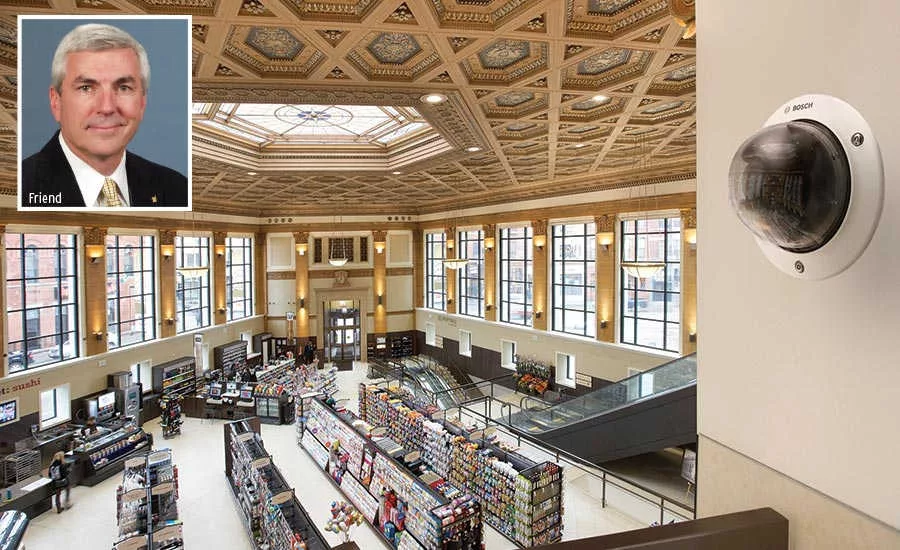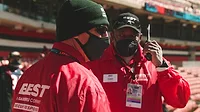Organized Retail Crime on the Rise; Perennial Challenges Remain
Major retail chains are working to upgrade their systems, policies to combat loss prevention threats.

Walgreens, with about 8,000 drugstore locations, has noticed the growth in organized robberies, says Hal Friend, director, physical security & fire prevention. “Organized robberies place us and our team members and customers at risk,” he says. “We use technology around that and procedures for employees … to comply with the demands of the individual and be a good witness later. We want a safe resolution to a bad event.” Photo courtesy of Hal Friend

Advance Auto Parts, which has about 5,500 stores and 42 distribution centers in the U.S. and Canada, has also noted the upsurge in organized retail crime, says Jeff Carr, asset protection solutions engineer. In Advance’s case, organized criminals often are trying to take advantage of the store’s returns policy, in some cases stealing items from a warehouse or store and then “returning” them to another location. Photo courtesy of Jeff Carr

Tom Meehan, director of technology and investigations, asset protection for Bloomingdale’s, says violent crime and organized retail crime are both on the rise, sometimes related and sometimes not. Photo courtesy of Tom Meehan

Dr. Read Hayes
An inexplicable rise in organized retail crime during the past couple of years, perhaps due to police passivity, has major retailers looking to upgrade their equipment, technology, policies and procedures, and training for employees to combat loss prevention. Meantime, perennial issues like shoplifting and credit card fraud continue to plague the sector.
The retail sector has been losing $40 billion to $50 billion in merchandise annually due to robbery, burglary and theft in recent years in addition to the employees and customers injured or killed when an armed intruder appears during business hours, says Dr. Read Hayes, director of the Loss Prevention Research Council and a research scientist at the University of Florida.
“Violence is off the charts as far as the rate of increase in the last 18 months or so,” he says. “Armed robberies and more serious organized burglary groups are happening at a much more increased rate.” FBI Director James Comey has called this “the Ferguson effect,” Hayes notes, with law enforcement pulling back because of their reluctance to be highlighted in the media – or worse.
“There’s been, over the last two, three years, some breakdown in the normal respect,” he says. “[Would-be criminals] don’t care as much, they’re not intimidated, they may feel entitled. The economy is clearly starting to improve a bit, so we don’t really know [why] crime appears to be growing on a macro level.”
Violent and Organized Retail Crime
Tom Meehan, director of technology and investigations, asset protection for Bloomingdale’s, says violent crime and organized retail crime are both on the rise, sometimes related and sometimes not.
“It’s in all verticals of retail,” he says. “Years ago, you would talk about convenience stores and drug stores. Today, it’s everywhere. It’s a topic that is constantly reviewed: what is happening and what measures can we take to make sure customers and employees are safe, and still manage our risk and loss potential.”
Meehan agrees with Hayes that the reasons are unclear and adds that upsurges in crime at retail don’t seem to track with overall environmental crime rates in particular cities. Retailers are lobbying states to pass legislation that more clearly defines organized retail crime vis-a-vis simple shoplifting, especially given the trend toward treating shoplifting as a legal violation rather than a crime with “softer” remedies such as restorative justice being put in place.
“There isn’t an industry-wide definition, and there isn’t a legal definition that is the same, state by state and municipality by municipality,” he says. “The industry is struggling with everybody calling [organized crime] the same thing but defining it differently. With shoplifting, you have a common understanding. But if everybody doesn’t agree what [organized crime] is, how do you come up with a solution in the legal system?”
The Loss Prevention Research Council has a working group that’s sharing best practices and sharing as much data as participants feel comfortable with to better understand the potential classifications as well as homing in on the risk model that will help delineate that “this store is more susceptible than others” to organized crime, Meehan says.
Walgreens, with about 8,000 drugstore locations, has noticed the growth in organized robberies, says Hal Friend, director, physical security and fire prevention. “Organized robberies place us and our team members and customers at risk,” he says. “We use technology around that and procedures for employees… to comply with the demands of the individual and be a good witness later. We want a safe resolution to a bad event.”
Advance Auto Parts, which has about 5,500 stores and 42 distribution centers in the U.S. and Canada, has also noted the upsurge in organized retail crime, says Jeff Carr, asset protection solutions engineer. In Advance’s case, organized criminals often are trying to take advantage of the store’s returns policy, in some cases stealing items from a warehouse or store and then “returning” them to another location.
The chain has deployed a tracking system called True Retail Equation to help identify and catch repeat offenders along with video technology to enhance that ability. Advance trains staff to be polite but vigilant, flagging certain familiar people from whom the Advance system will no longer accept returns, Carr says. “We see a familiar face and correlate it,” he says.
Shoplifting
In addition to the surge in organized retail crime, retailers are facing a number of other challenges and threats related to loss prevention. Shoplifting appears to be on the rise as well, Hayes says, and the Loss Prevention Research Council counsels first coming up with solutions that convince would-be thieves not to try a crime attempt because it will be too difficult – for example, because the item is behind a barrier, locked up or cabled down.
Step two consists of solutions that make the crime attempt riskier and the chances of getting caught to appear higher, Hayes says. This can include everything from alarms to watchful employees. And lastly, retailers can reduce the perceived benefit of a crime by, for example, placing ink tags on clothing that explode if not properly removed, or activating smart devices only as they’re purchased “so that item is just a brick” if someone steals it, he says.
Other solutions include detection technology that tracks how many of a particular item is being taken off a shelf at once, Hayes says. “If the normal selection rate is one item, and if, bam, all of the sudden somebody takes five or 10, the manager knows,” he says.
Some retailers have installed floor pads near high potential shoplifting locations that alert a store manager if someone is standing in the same spot for, say, more than a minute, Hayes says. “[The manager] gets a message that says, ‘Somebody is in the razor blade aisle,’ and they can go over and ask, ‘Can I help you?’ ” he says.
Meehan notes that retailers are becoming more aggressive and obvious about how they deploy video monitors, placing them at eye level rather than on the ceiling both to use newer facial detection technology but also because “at eye level, it forces someone to see it,” he says. “It says, ‘OK, this box is wrapped around your face.’ ” Camera quality is considerably better in 2017 than it was even earlier this decade, so retailers should upgrade, he
adds.
Walgreens employs signage to impress upon would-be offenders that lighting, alarms, cameras and other technology will be their attempts likely to fail, Friend says. “That’s our first opportunity to communicate to a person that this is not a good environment to do something bad,” he says. “Then, we have very overt cameras around the store. … CCTV is critical in that when there is an event that occurs, it will assist us and law enforcement to identify the offender.”
Robbery and Burglary
Walgreens also attempts to prevent robberies with time-delayed safes, used in the banking industry and other retail channels for many years but relatively new to pharmacy. “If they know there is a delay, and they’re going to have to wait, that increases the risk to them of being apprehended,” Friend says. “We always tell people, it’s a program, not a safe – it also includes signage at the front door and at the pharmacies. that notifies everyone in our stores, and we work with local media to inform the public that the technology is in use.”
The safes house select narcotics that offenders often target in robberies so they can either abuse the drugs, or sell on the streets, he says. In some cases they rob stores when they’re open, and in others there are burglaries. Walgreens has rolled out safes in certain areas where they’ve had the most difficulty and achieved a 90-percent reduction in such crimes, Friend says.
To combat burglaries, Walgreens has put into place alarm systems that start to sound before the intruder has even gotten inside. “Then they’re on the clock,” he says. “In the perspective of the intruder, he wants to get in, get what he wants, and get out before the police can arrive to apprehend him. … We de-incentivize them to come back because they’re not successful.”
Cameras help to identify what’s happening and the security video enables store personnel to tell the police exactly what’s happening from a remote security operation center that’s open 24/7, Friend says. They’re able to provide 911 operators specific information like, “We see two masked intruders coming in the front door, and one car in the parking lot,” he says. “It’s reasonable that they’re going to respond with more of their resources to a verified burglary-in-progress.”
"The reality is, a lot of these offenders are going to repeat until they’re apprehended."
Partnerships with law enforcement are critical, Friend says. Retail chains can help bring nearby police jurisdictions together around similar crimes in different locations that might involve the same offenders. “A big part of the strategy for us is preventing as many offenses as we can,” he says. “When they do happen, we assist law enforcement because the reality is, a lot of these offenders are going to repeat until they’re apprehended. We’re able to see emerging trends from a security perspective and build a strategy particular to that market.”
Omnichannel
In addition to protecting and preventing loss at physical brick-and-mortar locations, the trend toward “omnichannel” shopping, in which consumers order items online to be delivered to their homes – or picked up in store – has added to retailers’ challenges, Hayes says.
“With omnichannel, you have to be everywhere and do everything, so how do I keep track of all this?” he says. “There’s a much more complex movement of merchandise, money and information. How do you protect all of that?”
Retailers are now employing RFID technology to better track pallet shipments to make sure none are disappearing from warehouses or back rooms of stores, Hayes says. They’re also more thoroughly tracking and projecting where signatures should be required on delivered packages.
“If the evidence shows that if I put a package on a doorstep in this area, it might be seven or eight times more likely to be stolen,” a retailer requires a signature, he says. “How precise do I get? Sometimes being a few blocks away makes a big difference.”
Credit Card Fraud
Meehan cites credit card fraud as another growing loss prevention challenge for retailers. It’s coming under control with the belated rollout of chip cards – a solution Europe implemented more than a decade ago – but this also has created a new short-term headache because “the bad guys needed to get rid of inventory” and use non-chip cards that were about to be replaced. “That forces them to an online channel,” where the chip is not checked, he says.
To solve the dilemma of credit card fraud, the working group on fraud at the Loss Prevention Research Council has been facing down the challenge of convincing law enforcement that it’s not a victimless crime, says Meehan, who chairs that working group.
“It’s an industry-wide challenge, and everybody’s in a different place,” he says. “The person whose card is used gets their money back, so law enforcement is less inclined – they’re hard cases to work. That’s more about how do you use technology, from a data analytics standpoint, to identify [potential breaches] earlier.”
The working group has helped retailers partner with one another to identify benchmarks and “lean heavily on solution providers to come up with something different,” Meehan says. “If you’re a retailer today, are you investing in new technology constantly? Not so you’re keeping up with the Joneses but to make sure you’re the best protected.”
Lawsuit Fraud
Advance has been taking steps to offset losses of a different kind – to unscrupulous customers who file phony lawsuits against the company for slip-and-fall cases. The video technology used to catch would be merchandise thieves also comes in handy here, Carr says, adding that the potential expense of defending against a lawsuit helps to build a stronger case to support video deployments beyond standard threat assessments.
Overall, he says, “I don’t think you would get that kind of savings from shrink unless you had bandits in the store 24/7. We need to stop thinking that technology needs to be deployed strictly for traditional reasons.”
Council Provides Research Toward Solutions
The Loss Prevention Research Council, which has 11 working groups comprised of retailer and solution partner representatives, offers monthly phone calls and webinars to share best practices drawn from evidence-based research, says Dr. Read Hayes, director of the LPRC and its Crime Control Innovation Lab, and a research scientist at the University of Florida.
The council interviews criminal offenders to better understand the behavioral science of deterrence, and to figure out how to get the attention of would-be offenders in a credible way, to convince them not to attempt a crime, he says. Research staff, retailer loss prevention managers and solution providers brainstorm current issues, developments and targeted solutions based on more rigorous metrics.
These metrics help retailers better handle everything from responses to a suspicious vehicle parked in a fire lane, to facial identification technologies that reveal who’s accessing a particular location. For example, “If somebody’s trying to access a safe, the [store] manager can quickly identify, ‘That’s Betty, she’s supposed to be doing that.’ Or, ‘That’s Jim, he’s not supposed to be in there.’ Or, ‘I don’t know who that is,’ ” Hayes says.
Looking for a reprint of this article?
From high-res PDFs to custom plaques, order your copy today!





